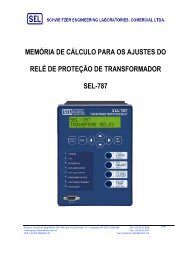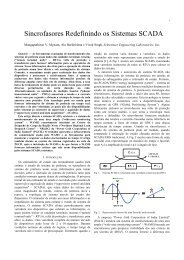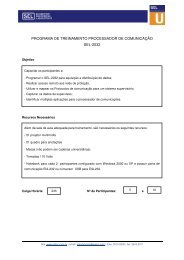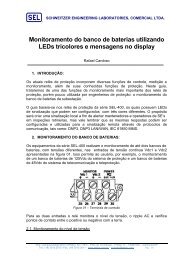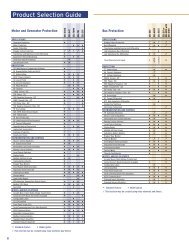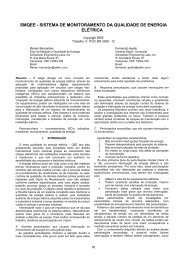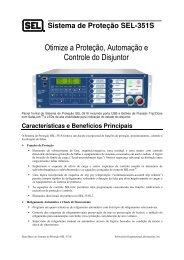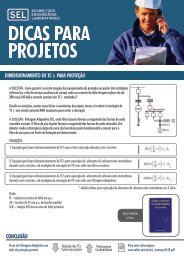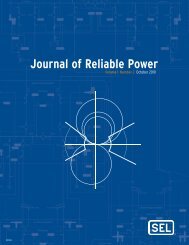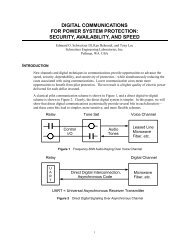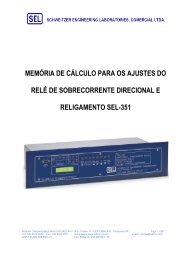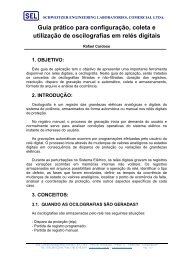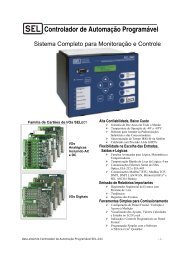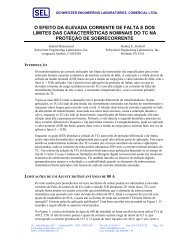Journal of Reliable Power - SEL
Journal of Reliable Power - SEL
Journal of Reliable Power - SEL
Create successful ePaper yourself
Turn your PDF publications into a flip-book with our unique Google optimized e-Paper software.
For an Aφ-ground fault on the system in Figure 8, the Aφground<br />
voltage at Bus S is:<br />
V A = m • Z1L • (I AS + k 0 • I RS ) + R AF • I F (2)<br />
Where:<br />
V A = Aφ voltage measured at Bus S<br />
m = per-unit distance to the fault from Bus S<br />
R AF = Aφ fault resistance<br />
I F = total current flowing through R F<br />
I AS = Aφ current measured at Bus S<br />
I RS = residual current measured at Bus S (3I 0S )<br />
Figure 8:<br />
System One-Line Diagram With SLG Fault<br />
The goal is to extract R AF from Equation 2. We must<br />
eliminate the line-drop voltage term, m • Z1L • (I AS + k 0 • I RS ),<br />
save the imaginary components, and solve for R AF . The result<br />
is:<br />
R<br />
Im ⎡<br />
⎢<br />
V • Z1L• I<br />
=<br />
⎣<br />
( ( + k •I ))<br />
( ( + k •I ))<br />
A AS 0 RS<br />
AF *<br />
Im ⎡I F• Z1L• IAS 0 RS<br />
⎢⎣<br />
The denominator contains I F , which includes fault and load<br />
current from both ends <strong>of</strong> the line. However, only Bus S<br />
currents are available to the relay at Bus S. We need to<br />
approximate I F in terms <strong>of</strong> Bus S current components. The<br />
approximation must be minimally system and load dependent.<br />
This last requirement permits setting the resistive thresholds<br />
with less concern that the resistive boundaries might be<br />
crossed under balanced load-flow conditions.<br />
Let I F = 3/2 • (I 2S + I 0S ), where I 2S and I 0S are the Bus S<br />
negative- and zero-sequence currents respectively. This<br />
current combination has all the available fault information,<br />
except the positive-sequence current (I 1 ). We specifically<br />
ignore I 1 because it is heavily influenced by load flow.<br />
Then:<br />
R<br />
=<br />
⎤<br />
⎥⎦<br />
⎤<br />
⎥⎦<br />
*<br />
⎡<br />
A ( ( AS<br />
+ k<br />
0•I<br />
))<br />
⎤<br />
RS<br />
⎣⎢<br />
⎥⎦<br />
( + ) ( ( + ))<br />
Im V • Z1L• I<br />
AF 3 *<br />
Im ⎡ • I I • Z1L• I k •I<br />
2 2S 0S AS 0 RS<br />
⎢⎣<br />
With this substitution, the fault resistance estimate <strong>of</strong><br />
Equation 3 is independent <strong>of</strong> balanced load. The 3/2 scale<br />
factor accounts for the missing I 1 contribution and ensures R AF<br />
measures the true fault resistance on a radial system. Infeed<br />
from Bus R causes R AF to increase, because our substitution<br />
for I F does not include any measurement <strong>of</strong> current from<br />
Bus R. For example, if the impedances on either side <strong>of</strong> the<br />
fault are equal, R AF is half the actual fault resistance.<br />
This method provides an easy means <strong>of</strong> testing R AF for<br />
both the left and right sides <strong>of</strong> the quadrilateral element:<br />
calculate R and test the result against ±R thresholds for each<br />
zone.<br />
*<br />
⎤<br />
⎥⎦<br />
(3)<br />
For example, a Zone 1 resistive boundary might test R AF<br />
against ±2 Ω. If the result is 1 Ω, this satisfies the criteria set<br />
for the Zone 1 quadrilateral resistive checks.<br />
VI. MAINTAINING DIRECTIONAL SECURITY<br />
Directional security is paramount. At first glance, mho<br />
elements appear directional. However, some safeguards are<br />
required to ensure security.<br />
A. Ground Direction Security Concerns<br />
Reverse Ground Faults: The operating quantities for all<br />
ground distance elements include residual current. For<br />
example, the residual current produced by a reverse Aφ<br />
ground fault is also used in the phase-ground distance<br />
elements for B and C phases. The residual current can cause a<br />
forward-reaching Bφ or Cφ ground distance element to<br />
operate. We can avoid this problem by supervising the ground<br />
distance elements with a directional element, by a phaseselection<br />
comparator, or by introducing additional conditions<br />
in a multiple-input comparator.<br />
B. Selection <strong>of</strong> Directional Element Input Quantities<br />
Negative-sequence directional elements have notable<br />
advantages:<br />
• Insensitivity to zero-sequence mutual coupling.<br />
• There is generally more negative-sequence current<br />
than zero-sequence current for remote ground faults<br />
with high fault resistance. This allows higher<br />
sensitivity with reasonable and secure sensitivity<br />
thresholds.<br />
• Insensitivity to vt neutral shift, possibly caused by<br />
multiple grounds on the vt neutral.<br />
Perhaps the major disadvantage is negative-sequence<br />
elements are rendered useless when one or two poles <strong>of</strong> the<br />
breaker are open.<br />
C. Compensated Negative-Sequence Directional Element<br />
When the negative-sequence source behind the relay<br />
terminal is very strong, the negative-sequence voltage (V2) at<br />
the relay can be very low, especially for remote faults.<br />
To overcome low V2 magnitude, we can add a<br />
compensating quantity which boosts V2 by (α • ZL2 • I2).<br />
The constant α controls the amount <strong>of</strong> compensation.<br />
Equation 4 shows the torque equation for a compensated<br />
negative-sequence directional element.<br />
T32Q = Re[(V2 – α • ZL2 • I2) • (ZL2 • I2)*] (4)<br />
The term (α • ZL2 • I2) adds with V2 for forward faults,<br />
and subtracts for reverse faults. Setting α too large can make a<br />
reverse fault appear forward. This results when (α • ZL2 • I2)<br />
is greater but opposed to the measured V2 for reverse faults.<br />
Distance Relay Element Design | 9



